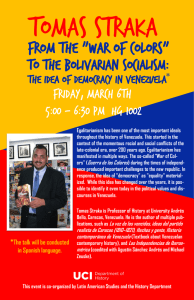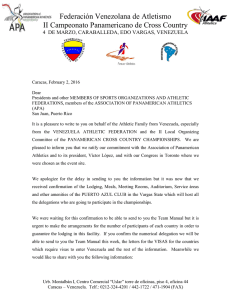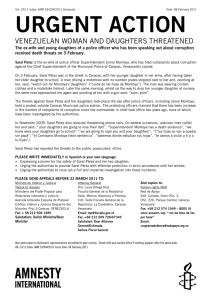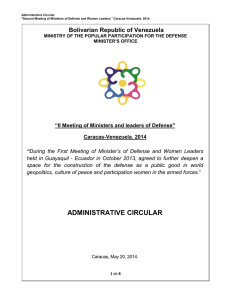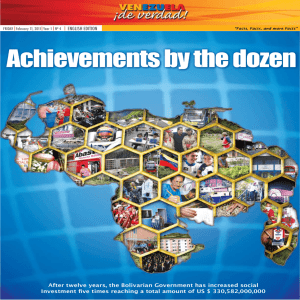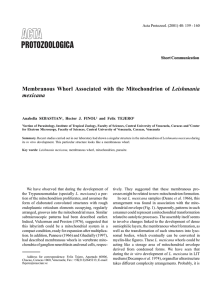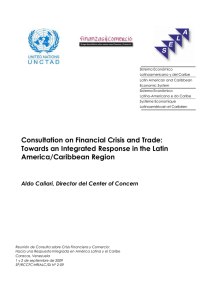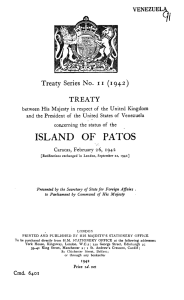Rogelio Altez, “New interpretations of the social and material impacts of the 1812 earthquake in Caracas, Venezuela” GSA Paper
Anuncio
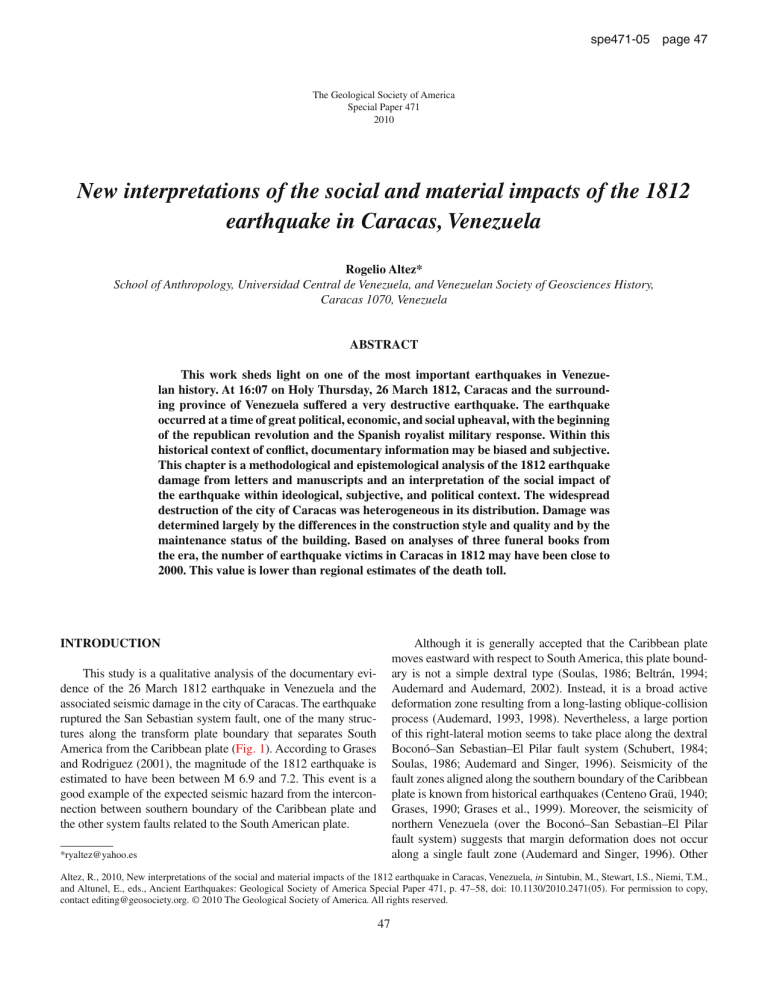
spe471-05 page 47 The Geological Society of America Special Paper 471 2010 New interpretations of the social and material impacts of the 1812 earthquake in Caracas, Venezuela Rogelio Altez* School of Anthropology, Universidad Central de Venezuela, and Venezuelan Society of Geosciences History, Caracas 1070, Venezuela ABSTRACT This work sheds light on one of the most important earthquakes in Venezuelan history. At 16:07 on Holy Thursday, 26 March 1812, Caracas and the surrounding province of Venezuela suffered a very destructive earthquake. The earthquake occurred at a time of great political, economic, and social upheaval, with the beginning of the republican revolution and the Spanish royalist military response. Within this historical context of conflict, documentary information may be biased and subjective. This chapter is a methodological and epistemological analysis of the 1812 earthquake damage from letters and manuscripts and an interpretation of the social impact of the earthquake within ideological, subjective, and political context. The widespread destruction of the city of Caracas was heterogeneous in its distribution. Damage was determined largely by the differences in the construction style and quality and by the maintenance status of the building. Based on analyses of three funeral books from the era, the number of earthquake victims in Caracas in 1812 may have been close to 2000. This value is lower than regional estimates of the death toll. INTRODUCTION Although it is generally accepted that the Caribbean plate moves eastward with respect to South America, this plate boundary is not a simple dextral type (Soulas, 1986; Beltrán, 1994; Audemard and Audemard, 2002). Instead, it is a broad active deformation zone resulting from a long-lasting oblique-collision process (Audemard, 1993, 1998). Nevertheless, a large portion of this right-lateral motion seems to take place along the dextral Boconó–San Sebastian–El Pilar fault system (Schubert, 1984; Soulas, 1986; Audemard and Singer, 1996). Seismicity of the fault zones aligned along the southern boundary of the Caribbean plate is known from historical earthquakes (Centeno Graü, 1940; Grases, 1990; Grases et al., 1999). Moreover, the seismicity of northern Venezuela (over the Boconó–San Sebastian–El Pilar fault system) suggests that margin deformation does not occur along a single fault zone (Audemard and Singer, 1996). Other This study is a qualitative analysis of the documentary evidence of the 26 March 1812 earthquake in Venezuela and the associated seismic damage in the city of Caracas. The earthquake ruptured the San Sebastian system fault, one of the many structures along the transform plate boundary that separates South America from the Caribbean plate (Fig. 1). According to Grases and Rodriguez (2001), the magnitude of the 1812 earthquake is estimated to have been between M 6.9 and 7.2. This event is a good example of the expected seismic hazard from the interconnection between southern boundary of the Caribbean plate and the other system faults related to the South American plate. *ryaltez@yahoo.es Altez, R., 2010, New interpretations of the social and material impacts of the 1812 earthquake in Caracas, Venezuela, in Sintubin, M., Stewart, I.S., Niemi, T.M., and Altunel, E., eds., Ancient Earthquakes: Geological Society of America Special Paper 471, p. 47–58, doi: 10.1130/2010.2471(05). For permission to copy, contact editing@geosociety.org. © 2010 The Geological Society of America. All rights reserved. 47 spe471-05 page 48 48 Altez Figure 1. Diagram of plate boundaries of Venezuela (after Audemard et al., 2000). small earthquakes can be localized on minor faults that everywhere cross the principal systems (Audemard et al., 2005). The fundamental aim of this investigation is to estimate the earthquake intensity, earthquake fatalities, and potential microzonation of damage (e.g., Altez and Laffaille, 2006). This historiographic approach to assessing damage in the 1812 earthquake (see Altez, 1998, 2005a, 2006) contrasts with previous studies that have focused solely on assigning earthquake intensities, drawing isoseismals, or exclusively on the style of structural damage (as an example of that, see FUNVISIS, 1997). As stated by Mocquet (2005, p. 130): “The assessment of macroseismic intensities from historical reports requires one to combine information on vulnerability and damages. Similar earthquakes occurring at different epochs can produce different effects, depending on the demography and local life conditions at the time of occurrence.” Critical analyses of historical information pertaining to earthquakes, i.e., the field of historical seismology, utilize methodological approaches and knowledge across the disciplines of seismology, history, anthropology, and earthquake-resistance engineering (Guidoboni and Ferrari, 2000). Three fundamental variables should be understood and analyzed in order to sufficiently reconstruct damage from a seismic event. The most important of these variables is the historical context in which the seismic phenomena took place and the information and direct testimonies concerning the impacts and effects that are recorded. Understanding this historical context leads us to comprehend the information that was elaborated on and discussed at that moment in history. This has been called a “critical joint” (Olson and Grawonski, 2003) or “disaster juncture” (Altez et al., 2005). Emerging from complex circumstances at a time of military conflict, the 1812 earthquake is recorded with different perspectives from the initial experience and later interpretations of the event. A second variable in understanding this historic seismic event lies in the material context of the built environment. Observations of the constructive typology and construction conditions at the time of the earthquake are important parameters for assessing the intensity of damage (Altez, 2005a; Yamazaki et al., 2005). Damage in the earthquake is quantified on the European Macroseismic Intensity Scale (EMS, 1998), ranging from I through XII. In assessing the specific construction damage, the “Classification of damage to masonry buildings” (also from EMS, 1998), which ranges from I to V, is particular useful. Lessons from the social impacts of this disaster also are learned from the extent of material destruction and the subsequent consequences felt in the population. Finally, the number of earthquake fatalities is an important variable that is often open for interpretation. The number of deaths in the earthquake provides a good estimation of the severity of the event. To calculate the number of deaths in the earthquake, I extrapolate data from multiple sources. The results of these analyses of the historical spe471-05 page 49 The social and material impacts of the 1812 earthquake in Caracas, Venezuela text for seismic intensities and the number of fatalities seem to be far from classic studies on the 1812 Caracas earthquake and provide a new interpretation on this catastrophic phenomenon in the history of Venezuela. HISTORICAL CONTEXT OF VENEZUELA IN 1811–1812 The political events in South America in the early nineteenth century would transform American society forever. Venezuela, as well as most of the Latin American continent, was on a tortuous road from 300 yr of colonial rule toward independence. In July 1811, Venezuela declared independence. This caused an acceleration of the breakup of the institutional and administrative bonds with the Spanish crown, which was then in crisis due to the Napoleonic invasions. In March 1812, before the earthquake, a small royal army started out from the city of Coro, 500 km to the west of Caracas, heading toward the main city with the objective of recapturing the rebellious counties (for a general approach to the historical context, see Lynch, 1985, or Guerra, 1992). The earthquake of 1812 occurred during the Holy Week between Palm Sunday and Easter, with all of its Christian celebrations, magnificence, and ritual ceremonies. The 26 March 1812 was Holy or Maundy Thursday. The religious mandates for the day were rigorously fulfilled, even more in those days, when faith still had an indisputable nature. Most of the population of the region was concentrated in the city of Caracas (Fig. 2), the province capital (territory) of the General Captainship (jurisdic- 49 tion) and of the Archdiocese (major ecclesiastical authority) of Venezuela. Caracas was also the administrative, institutional, and political center. Thus, Holy Thursday included the presence in the capital city of the most prominent civil, military, and ecclesiastical authorities. In the middle of this religious ceremony, and the threat from the royal invasion and political tension, a dreadful earthquake struck the city at 4:07 in the afternoon. Because the earthquake occurred at this turning point in history between colonial rule and independence, the extent of the damage in the event has become an interpretive problem complicated by heroic and nationalistic reconstructions of history. The fall of the patriots’ ambitions, the solid discourse of the Christian faith, the royal manipulation, the denial of the independence movement, and the exaggeration of the context narrators are all factors that have colluded in the overestimation of the importance and magnitude of the tragedy. The critical conditions imposed by the war, including destruction, abandonment, and migration, contributed to the hopeless loss of information. Files were destroyed in the collapse of buildings, lootings occurred on both sides, paper was used for fuel in bonfires that protected against the cold night in the outdoors, and any type of paper was used to ram the gunpowder for combat; all this combined to produce the information loss that is sorely missed today (for a detailed description on the matter, see Altez, 2006). The 1812 Venezuelan earthquake is categorized by all historians and investigators as one of the largest in the country’s history. Information written about this earthquake was motivated by many reasons. This has potentially contaminated the context Figure 2. Caracas and its faults (detail from Audemard et al., 2000). spe471-05 page 50 50 Altez of the point of view of the chronicler, suggesting bias in opposing or supporting one side of the nationalism movement and the war of independence. MATERIAL CONTEXT: THE CITY OF CARACAS IN 1812 From an urban point of view, in 1812 Caracas was not a major city compared to other capitals of the Spanish colonial world. More impressive economic and architectural development and higher population densities were found in cities such as Mexico, Lima, and Bogotá. However, Caracas had shown signs of institutional growth since the late eighteenth century. The appointment of the General Captainship in 1777, the Royal Audience in 1786, the Royal Consulate in 1793, and the Archdiocese in 1804, granted to the capital of the Province of Venezuela considerable status. By 1810, Caracas was the center of political power and economic growth. However, these aspects had not yet decisively impacted the city’s architecture. Urban development in Caracas at the time of the 1812 earthquake lagged behind its other American contemporaries (Fig. 3). Basically, in early nineteenth-century Caracas, the public buildings were old and ill-maintained (Table 1). Most documentation from Caracas and the region, written by the priests narrating the churches’ condition, denounced the dramatic situation of their structures. They describe cracks, roof problems, and infestations Figure 3. Map of Caracas near 1810, by Mendoza Solar (1910). spe471-05 page 51 The social and material impacts of the 1812 earthquake in Caracas, Venezuela of ants and termites. On 25 August 1812, the Archbishop of Caracas, Narciso Coll y Prat, when speaking about conditions of the cathedral prior to the earthquake, stated that the church was “old, incompetent, disproportionate…” (Coll y Prat, 1812). In 1812, the only structures in the city of considerable height were the churches, based on the rationale that no construction could show more height than “the house of God.” The only tall structures in Caracas in 1812 were the towers of the churches (Grases et al., 1999). Thus, the remaining constructions were of lower and smaller size, as seen on the perspective view of Caracas in Figure 4. Most houses were of typical colonial architecture, with a single story and a central patio. Building materials varied between adobe, bahareque, and masonry. The testimonies of travelers and visitors at the beginning of the nineteenth century attest to the fact that Caracas hardly had any two-storied houses (e.g., Ker Porter, 51 1997; Duane, 1968). In this sense, when speaking of “buildings,” one should emphasize both the small size and scale. Constructions in the city can be classified into three groups: churches (high buildings with towers), public administration buildings (generally two-storied and spacious houses), and living quarters or housing (low structures built in three different styles). The role of construction type was a determining factor in whether the building collapsed in the earthquake. As deduced from the historic documents, the materials used for the housings and buildings construction were not able to withstand the seismic shaking. According to Pedro Cunill Graü (1987), the housings of the poorest members of society were made of bahareque (stick interwoven with canes and mud) and were roofed with straw or palms. Constructions in the middle sector of the society (merchants and artisans) had adobe, walls reinforced by thin trunks to hold roofs of straw or tiles. The houses of the richest levels of TABLE 1. AGE OF SOME OF THE CONSTRUCTION OF MAJOR STRUCTURES IN CARACAS AT THE TIME OF THE 26 MARCH 1812, VENEZUELAN EARTHQUAKE Construction Approximate year of construction Cathedral Church Built as parish church toward the second half of the sixteenth century. Remodeled in 1636 as a cathedral and as the seat of the Diocese of Venezuela. Rebuilt after the 1641 earthquake. Altagracia Church 1656 La Pastora Church 1745 San Pablo Church 1580 La Merced Church 1638 San Mauricio Church 1570. Rebuilt in 1667, after the damages received in the 1641 earthquake. San Jacinto Church Late sixteenth century San Lázaro Hospital Construction initiated in 1759. La Candelaria Church 1708 Santa Rosalía Church Built as church in 1732, before it was a chapel. La Concepción Convent 1619 Carmelitas Nuns Convent 1739 Seminar School 1675. Recently repaired, with construction works that lasted from 1809 through 1811. Figure 4. Detail of the painting titled Nuestra Señora de Caracas, painted in 1766 (artist unknown) and currently located in the Consejo Municipal of Caracas. Note the height of constructions of the time. Church towers and some few two-storied buildings are the only tall buildings and are concentrated around downtown. spe471-05 page 52 52 Altez the community were built with adobe and stone walls with brick facades, wooden barred windows, and tiled roofs. The houses of the upper classes generally had very elevated roofs that made them more fragile during the earthquake (Ker Porter, 1997). Civic and religious constructions were mostly built of wooden frames with stone facades brick arches, tiled roofs, and whitewashed walls. According to Alejandro Ibarra (1862), the quality of the period constructions was highly responsible for the earthquake damages: “The limited depth of the bases or lack thereof, materials of diverse density and shapes and even of inappropriate nature, which were indiscriminately used to make the main walls of even the larger buildings: their lack of thickness, the use of poor quality mortar and other mistakes related to the art of building, were causes that undoubtedly contributed to increase the devastation of the 1812 earthquake” (p. 2). The conditions pointed out by Ibarra (1862) are of great value, since he was a pioneer in the investigation of the effects of the 1812 Venezuelan earthquake closer to the date of the earthquake and prior to the massive transformations of the city in the twentieth and twenty-first centuries. EARTHQUAKE DAMAGE The earthquake effects of 26 March 1812 were devastating in Caracas. As all documentation points out, Caracas was in ruins (Delpeche, 1813; Díaz, 1829; Palacio Fajardo, 1817). Descriptions near the date and detached from all political or romantic ideas are very eloquent. In the first days after the disaster, the Cabildo (the city council) meetings reassured the citizens, calling on them to make efforts to better the conditions of the city. The city council ordered cleanup of the debris in the streets, thus allowing access to Caracas for food deliveries from outside of the city (Actas del Cabildo, 1972). These first orders exemplified the critical necessity of provisioning the city. The roads drew a perimeter around the city, leading to the Capuchinos square, where provisions would be received. The types of structural damage in the earthquake were very diverse and largely determined by the type of construction, which in turn was based on social class. According to Cunill Graü (1987), the underprivileged classes formed suburbs in the periphery of the city, while the most notable and powerful citizens resided in blocks near the city center. The same author states that the housing of the poorest suffered less damage in the earthquake because they were built of bahareque (more earthquake-resistant material in his opinion). It can be inferred that there would be fewer victims in these houses due to light cane roofs that would be less fatal than the collapse of a tile roof. However, testimony of the city council and the orders of Spanish government given in August (Monteverde, 1812; Actas de Cabildo, 1972) indicate that debris was abundant throughout the city. The house construction types of the middle and upper classes were vulnerable, with very heavy and high roofs of tiles propped up by weak thin trunks. It is assumed that these houses caused the largest quantity of deaths and destruction. In the burial certificates that could be found (Book of Burials, La Candelaria Parish, number 7, 1806–1817; Book of Burials, Adults, San Pablo Parish, 1808–1812; Book of Burials, Chacao Parish, number 2, 1797–1821), most of the deceased registered by the priests in charge died in their houses. There was a high death toll of maids, children, and slaves because families were at the celebrations in the cathedral at the time of the earthquake. The damage in the more important buildings seems to have been related to the quality of their construction and materials. Ibarra (1862, p. 2–3) stated: An example of all this is provided in the temple of Altagracia whose walls especially the South one and surely that of the North, also built as just said, came to earth and with them all the temple; at the same time its beautiful front that is of good construction resisted the shakes of the tremor and the shudder that should cause the fall of its arched roofs and its very solid and heavy construction. In the same way in the convent of San Jacinto whose interior new factory, was built with bad materials, came to the floor, conserving the old external one that had resisted the earthquake of 1641; and the one that was made immediately after, heavy and rough, but of solid construction, being noticed that the walls built with raw adobes made of pure mud and straw, resisted perfectly, when the poor built masonries with mezclote [some kind of varied and mixed materials] were quartered, disjointed and destroyed they didn’t fall, already decomposed the mezclote and loose fitting bodies that entered in the formation. Another document (Larrain, 1958) estimated that of the 5000 existing houses in Caracas before the earthquake, only 2000 were left standing. Larrain was referring to the housings, and not to the religious buildings or public administration houses. Little mention is given to civic buildings, since the government had been displaced by the revolution. However, it calls attention to the omission of this information. It may be inferred that they suffered less damage. This type of construction (two-story, roomy, stone, adobe houses with lime walls and tile roofs) resisted destruction in the earthquake. Beyond the materials used in construction, it seems that the quality of the building was decisive in the survival of the structure. Houses built with greater care and better resources, such as the spacious public administration and those of the most prominent citizens in Caracas, seem to have suffered less damage, while those that were built with fewer resources and were old or poorly maintained in their structure (bahareque with cane, heavy roofs propped with fragile and weak tied supports) were less lucky. It can be inferred that the collapse of the roofs was responsible for most of the damage and fatalities. IMPACT ON THE SOCIETY The earthquake of 26 March 1812 occurred in an area unprepared to face earthquakes, and thus produced impressive losses. Alex Scott, commissioned from the United States to observe closely the new revolutionary government, calculated the losses spe471-05 page 53 The social and material impacts of the 1812 earthquake in Caracas, Venezuela in Caracas and La Guaira (near the port 20 km to the north of Caracas) at about four million dollars (Scott, 1812). War across the whole territory had bankrupted the administration by 1812. Also, public funds had collapsed. The country’s largest population by percentage, mestizos (natives and slaves), was structurally poor. Losses in the state treasury must then be envisioned with respect to a population with little wealth. The loss of the churches also meant sacrifice in funds and labor, since the majority was not able to assume the responsibility of reconstruction. Economically, the earthquake affected the religious population, who hardly had the means to go to mass. In a structurally poor society, churches were in a poor state of repair and underfunded, since most of the parishioners were mestizo and not white criollos (creoles) and wealthy people. Descriptions of the ruins repeat in all the documentation, giving account of the earthquake damages and sufferings of the reconstruction. The population was devastated by the lack of resources, besides being pressured by ongoing war. In Caracas, the earthquake damage blocked roads and access to provisions. Later, when the disaster reached its maximum expression, the Consulate of Caracas, from which the Intendant Dionisio Franco (1813) had requested a loan of 100,000 pesos, responded as follows: “The same powerful causes that have influenced from the year 1810 until the present in these Provinces, reducing them to the impossibility of covering the expenses that circumstances demand, has caused the extraordinary backwardness that experiences the trade and the agriculture, particularly in this Province, that above all not only suffering losses being consequence of the political events occurred in that epoch, but also those of the great earthquake of last March 26 that had just ruined the harvesters class” (Consulate answer to Intendant, 29 January 1813). The same text later argued that among other reasons, the consulate by itself was not able to ordinarily congregate, because there was not “...in the City enough number of individuals... whom to summon for it by effect of the same things and in the emigration that there was towards the country following the earthquake in where they still remain in terms that Government’s Meetings have sometimes stopped to be made by lack of vowels....” The merchants were also paralyzed due to the blockade suffered by the region. Even so, it was frankly recognized that, although “they are the only ones who can be counted on in similar difficulties,” the same ones were in a “general poverty.” “New contributions and loans cannot be counted on due to the general poverty of these inhabitants, caused by the revolution, earthquakes and also the recovery of the legitimate Government....” (Dionisio Franco, manuscript dated 13 February 1813). To this crisis picture in the public and private funds of the administration, the characteristic poverty of the society should be added. In this way, all suffered the catastrophe, although not equally. Church restorations represented the same tragedy in Caracas as in all the towns of the region. Undoubtedly, this was due to the lack of resources of all kinds. By 1816, efforts were made to plead the situation of Caracas churches to the city council. How- 53 ever, the political passions would continue slowing things. When the city council requested the report about “the resulting destruction caused in the two revolutions that have afflicted them and by the horrendous general earthquake of March twenty six 1812,” the secretary answered: “…almost all Churches are ruined more or less and many totally. (...) that the [Metropolitan] Church for repairs, like the ruins of their building are repairing, to restore some necessary pieces of jewellery and to make the costs of the precise one for the divine cult, is using extraordinary wills, or taking borrowed money, or receiving it to census....” (Guzmán, 26 April 1816). The earthquake’s damage repairs were delayed by the economic and societal problems. The recruitment and maintenance of a labor force were drained by migration. The repair of churches, room houses, and public administration was also delayed many years because of the deep economic crisis. Similarly, the negative consequences in the population distribution in the urban core caused the city housing to be abandoned and the development of new suburbs. This seriously affected location and image of the capital: “...to which is added that thinking that most of the inhabitants not to live more in the City again, with the object of living in the uninhabited places, unroofed their houses, pulled out their doors and windows with their wood, and these pieces to build shacks where to be....” (Méndez, 18 April 1816). With the destruction caused by the 1812 earthquake, certainly the horizons of the cities, towns, and villages were changed forever. That destruction also contributed to the transformation of the colonial society. To lift a nation from that debris was not, in spite of the nationalist historiography, a heroic gesture, but an unavoidable situation accompanied by hopeless circumstances. EARTHQUAKE FATALITIES At the time of the earthquake, the city of Caracas was the most populated in the whole Province of Venezuela. According to Cunill Graü (1987), in 1812, Caracas had 50,000 inhabitants. A more precise figure is given by Díaz (1817) of 31,813 people. If we compare the population figures with the number of houses (5000 noted by Larrain, 1958), then the average number of inhabitants per home was about six people. The earthquake occurred on Holy Thursday in the middle of the afternoon when most people of the city were in the Main Square in front of the Cathedral celebrating the services. Therefore, houses were not fully occupied at the time of the earthquake. It is quite likely that had the houses been fully occupied, the number of deaths would have been higher. The number of deaths for the 1812 Caracas earthquake has been at times confused with the death totals caused by the war, the mandatory migrations, and the famine. To understand the disastrous consequences of these last aspects, Cunill Graü (1987) conducted a detailed analysis in this respect. As noted earlier, that confusion is clearly linked to the critical historical context and to the meaning of that same context subsequently for the country’s spe471-05 page 54 54 Altez later history. At a time in which such a profound transformation of society was starting to take place with the birth of a new nation, information was managed or exaggerated for political gain (Guidoboni and Ferrari, 2000; Rodríguez and Audemard, 2003). Later, when those years of crisis were transformed by historical discourse into a revolutionary story, nobody dared to question the heroic conditions of the transformation. The tragedy of the earthquake helped manifest and heighten the revolutionary ideal of heroic triumph over adversity. The nation’s genesis mythology needed its heroes to sufficiently overcome her adversaries. This is why the war, the earthquake, and all the circumstances of that moment became the most critical moments in Venezuelan history: They are the heroic genesis of the nation. However, this does not make the history of the period an unbiased record of the truth. The death figures for the 1812 earthquake vary widely, as seen in Table 2. These figures were obtained from documents from contemporary narrators and from nineteenth- and twentiethcentury investigators. They are certainly the well-known death numbers related to the earthquake in Venezuelan historiography. Between the 20,000 of Forrest (1812) and the 1000 of Roscio (1812), the difference is very significant. Of all of the estimations, only Coll y Prat (Archbishop of Caracas in 1812) declares that his figures come from an order to the priests of his diocese. Indeed, that order was extended to all his parishes on 6 April 1812 (Coll y Prat, manuscript of 31-03-1812), but the replies from his whole jurisdiction have not been found in their entirety. Fatality figures by Coll y Prat (1816) include all the parishes and towns to which the request was made, and not exclusively from the city of Caracas. Furthermore, Díaz (1817) stated that the number of inhabitants in the province indicated that 13,000 persons “died with the earthquake.” This value accounts for the entire population of the provinces in the whole jurisdiction of Venezuela. The 1000 deaths in Caracas pointed out by Roscio (1812) are derived from a seemingly very conservative number. In the San Carlos military quarter of the city, ~500 individuals are said to have perished (Delpeche, 1813). Díaz (1829) wrote an eyewitness account of 40 people dying in the collapse of one convent of the Order of Predicadores in the Square of San Jacinto. One way to derive an independent estimation of the earthquake fatalities is to consult the funeral records. However, it was only possible to find three funeral books that correspond to March 1812 (Table 3). Only two of the funeral books are from the urban area of Caracas. The third funeral book is from the Chacao parish, a small town on the outskirts of the city. The funeral book data show a total of 137 deaths from three different parishes. Extrapolation of this fatality rate to the rest of the city is probably not appropriate because it may not represent earthquake damage and building collapse in other parishes of Caracas. In total, Caracas had as many as 19 parishes inside the urban perimeter, and thus calculations of the death numbers with data coming from only two of the parishes are highly uncertain. It is significant that the death numbers registered by the priests of these parishes take into account the total of the jurisdiction, including, obviously, the housing and not only the churches. TABLE 2. NUMBER OF DEATHS FROM THE 1812 EARTHQUAKE IN CARACAS No. of deaths Source 15,000–20,000 Forrest (1812) 16,000 Ker Porter (1825–1842) 14,000 Centeno Graü (1940) 10,000–12,000 Coll y Prat (1960, originally from 1818) 10,000 Rojas (1879) 10,000 Heredia (1895) 9000–10,000 Delpeche (1813) 8000 Irvine (1818) 7000 Parra Pérez (1939) 6000–7000 Urquinaona y Pardo (1820) More than 6000 Ascanio (1813) 3000 Semple (1812) 1000 Roscio (1812) TABLE 3. NUMBER OF DEATHS FOR THE 1812 VENEZUELAN EARTHQUAKE DERIVED FROM FUNERAL BOOKS OF THE CARACAS REGION No. of deaths Parish Source 83 La Candelaria Book of Burials, 1806–1817 38 San Pablo Book of Burials, 1808–1812 16 Chacao Book of Burials, 1797–1821 Consequently, it is a registration that embraces several (perhaps 8–10) blocks around a church. In a radius of some 10 blocks (the probable maximum for the case of La Candelaria), there were 83 deceased. With this value, it is difficult to reconcile a total Caracas death toll of 20,000 (Forrest, 1812) or 12,000 (Coll y Prat, 1818) or 6000 (Parra Pérez, 1939). Even if the La Candelaria parish death toll is increased to 100 fatalities and applied to each parish and the 500 deaths from the San Carlos Military Headquarter are added, the total number of deaths for the area of 19 parishes is 2400 people. The conservative figure of Roscio (1812) and the approximate value of 3000 by Semple (1812) are close to this calculation. The larger 100 deaths per parish is approximately a 20% increase over the funeral records from the La Candelaria parish. The 38 deaths from the San Pablo parish funeral book are more than 50% less than that of the La Candelaria parish. The total number of deaths in the earthquake across Caracas would be an even lower number if we assumed 38 deaths from each of 19 parishes. Utilizing an average fatality rate from the funeral books of 60 deaths per parish yields a death toll estimation of 1640. Together, an average of these calculations suggests that ~2000 people died in Caracas in the earthquake (Altez, 2005a, 2006). INTENSITIES The widespread destruction of Caracas city was heterogeneous in its distribution. Damage was determined largely by the differences in the construction quality and by the maintenance status of the buildings. A spatial relationship between damage and social class therefore does not exist (Cunill Graü, 1987). The condition of the building at the time of the earthquake explains why there were churches with more or less damage. Some buildings spe471-05 page 55 The social and material impacts of the 1812 earthquake in Caracas, Venezuela were virtually unharmed, and others totally collapsed. There were houses that resisted shaking and others that acted as the burial ground of the people. Estimation of the intensity of the earthquake is more difficult if the extent of damage is related to construction age and quality. The heterogeneous destruction of the buildings and a lower death count found in one historical record for Caracas can now be better appreciated. Table 4 summarizes the reported structural damage in Caracas. Values range from 33% to 90% of the buildings destroyed. These values appear as broad estimations of the areal percentage of damage. Modern assignment of Modified Mercalli scale (MMS) intensity values for Caracas are based on the historical damage records and include MMS X (FUNVISIS, 1997), MMS IX (Fiedler, 1972; Grases, 1990; Altez, 2005b), and MMS VIII–IX (Altez, 2005a). Thorough investigation of the historical sources suggests a lowering of the intensity values (Altez, 2005a). In all these observations, the earthquake intensity values for Caracas are high. However, the Modified Mercalli scale allows only a general perspective of the macroseismic effects. According to the map presented in this work (Fig. 5), it is possible to assign intensities to each damage site reported in the city using the EMS scale. This map shows that the damage distribution varies and can lead to a microzonation of intensity values. The largest variety of building responses to the earthquake is around the Main Square. In the north area, the damage level is V in the EMS scale. For the rest of the city, EMS values of IV are based on the analyses of the quantity and level of destroyed houses. Toward the north, the city felt a tremor that produced general damages with an EMS intensity of V. Most of the city of Caracas felt EMS intensity IV values (Altez, 2005a). CONCLUSIONS From the analyses of the historical data, the following conclusions are drawn: 1. The intensity values for the earthquake of 26 March 1812 in the city of Caracas have been overestimated by previous investigators. The reason for the higher intensity values is the lack of a critical evaluation of the historical context of the primary sources and the initial conditions of the buildings at the time of the earthquake. 55 2. The disaster was not the action of only one negative force (i.e., the earthquake). The earthquake occurred during a time of war and at a critical transition point in Venezuelan political, economic, and societal history. The war, the paradigmatic change represented by the pass from colonial society to forced modern institutions, and the social and political ambition of the criollos produced a vulnerable historical context. 3. The damage distribution from the earthquake of 1812 in Caracas is heterogeneous and determined by the quality and state of construction. This explains why the damage does not directly correlate with the constructions of the social classes or with the size of the construction. 4. The number of earthquake victims in Caracas in 1812 may be closer to 2000, based on analyses of three funeral books from the era. This value is lower than previous estimates about the deaths cipher. 5. The number of fatalities caused by the earthquake in the city of Caracas has been generally overestimated and historically confused with the deaths caused by other factors that were occurring concurrently, including war, migration, and famine. 6. A greater number of deaths is attributed to collapse of houses and not of religious and civic buildings. Most inhabitants were at the cathedral in celebration of Holy Thursday. Those inhabitants who remained in domestic dwellings were more likely to be killed because the roofs of houses were high, heavy, and had fragile support, making them very susceptible to collapse. 7. A seismic microzoning analysis of the city shows damages distributed among intensity values III, IV, and V on the EMS scale, with 46% of buildings and 60% of houses with damage V, while 46% of the buildings show damage IV. 8. The north area of the city of Caracas experienced higher seismic intensities (EMS V) compared to the rest of the city (EMS IV). This conclusion was also reached using similar methods by Altez (2005a), Yamazaki et al. (2005), and Schmitz et al. (2005, 2008). ACKNOWLEDGMENTS Thanks are due to Franck Audemard, André Singer, Jaime Laffaille, and Franco Urbani for their advice and lessons in seismology and geology. Special thanks go to Tina Niemi for her effort in the corrections to and observations about the manuscript. Also, the author is grateful to Raquel Vidal, student of anthropology, TABLE 4. DAMAGE ESTIMATIONS FROM THE 1812 EARTHQUAKE IN THE CITY OF CARACAS Damages Source 9/10 parts of the city destroyed Delpeche, mentioned in Centeno Graü (1940), 15 May 1813 3000 destroyed houses Larrain (1958) Almost all the churches and 2/3 of the houses Urquinaona y Pardo (1820) 50% of the city ruined Méndez (1957, originally 1816) 7 churches completely ruined and the rest can be repaired Linares (1816) 1/3 of the houses completely ruined 1/3 of buildings fallen Coll y Prat (1960) 50% of houses fallen Díaz (1829) 8/10 parts of the city destroyed Ibarra (1862) spe471-05 page 56 Figure 5. Detailed damages of Caracas. The dark points show the most destructive effects (V in “Classification of damage to masonry buildings” from EMS scale), and the light points show the minor damages (III–IV). spe471-05 page 57 The social and material impacts of the 1812 earthquake in Caracas, Venezuela for her help in the final corrections. This article is a contribution to the United Nations Educational, Scientific and Cultural Organization–funded International Geoscience Programme IGCP 567, “Earthquake Archaeology: Archaeoseismology along the Alpine-Himalayan Seismic Zone.” REFERENCES CITED Historical Primary and Secondary Sources Actas del Cabildo de Caracas, 1972, Volume II, 1812–1814: Caracas, Venezuela, Concejo Municipal del Distrito Federal, Tipografía Vargas, 412 p. Ascanio, 1813, Antonio Ascanio, Autobiografía, may be from 1813: National Academy of History Archive, Francisco Javier Yanes Section, volume 28. Book of Burials, Adults, San Pablo Parish, 1808–1812, Book IX, 1808–1812: Caracas, Venezuela, Archdiocese Archive of Caracas, Episcopal Section. Book of Burials, Chacao Parish, No. 2, 1797–1821, Book 2, 1797–1821: Caracas, Venezuela, Archdiocese Archive of Caracas, Episcopal Section. Book of Burials, La Candelaria Parish, No. 7, 1806–1817, Libro de Entierros de la Parroquia La Candelaria: Book 7, p. 1806–1817. Coll y Prat, manuscript from March 31, 1812, Narciso Coll y Prat, Circular a Todas las Parroquias y Pueblos del Arzobispado de Caracas: Caracas, Venezuela, Archdiocese Archive of Caracas, Parishes Section. Coll y Prat, 1957, April 18, 1816: Narciso Coll y Prat, in Los Desastres del Terremoto de 1812: Crónica de Caracas, v. 32, p. 535–536. Coll y Prat, N., 1960, Exposición al rey, 1818, in Memoriales de la Independencia de Venezuela: Caracas, Venezuela, Biblioteca de la Academia Nacional de la Historia, p. 85–386. Consulate answer to Intendant, January 29, 1813, Archivo General de Indias (General Indias Archive): Caracas, Venezuela, File 824. Delpeche, L., 1813, Relación del último terremoto de Caracas: Journal de Paris, 15 May 1813, p. 1. Díaz, J.D., 1817, A los autores y agentes del 19 de abril: Gaceta de Caracas (journal from Caracas), May 21, p. 1027–1034. Díaz, J.D., 1829, Recuerdos sobre la Rebelión de Caracas: Madrid, Imprenta de León Amarita, 408 p. Dionisio Franco, manuscript dated in February 13, 1813, Archivo General de Indias (General Indias Archive): Caracas, Venezuela, File 824. Duane, W., 1968, Viaje a la Gran Colombia en los años 1822–1823: De Caracas y La Guaira a Cartagena, por la Cordillera hasta Bogotá, y de aquí en adelante por el Río Magdalena: Caracas, Venezuela, Instituto Nacional de Hipódromos, 372 p. Forrest, 1812, Forrest (captain) to admiral Stirling, Curazao, March 30, 1812, in Parra Pérez, C., 1939, Historia de la Primera República en Venezuela, Caracas, Volume II: Caracas, Venezuela, Tipografía Americana, p. 211–212. Guerra, F.-X., 1992, Modernidad e Independencia. Ensayos Sobre las Revoluciones Hispánicas: México DF, México, Fondo de Cultura Económica, 407 p. Guzmán, April 26, 1816, Juan Joseph Guzmán, in Los Desastres del Terremoto de 1812: Crónica de Caracas, 1957, v. 32, p. 537. Heredia, J.F., 1895, Memorias Sobre las Revoluciones de Venezuela: Paris, Librería de Garnier Hermanos, 304 p. Ibarra, A., 1862, Temblores y Terremotos: El Independiente (journal from Caracas), April 1862, no. 587, p. 3–4. Irvine, 1818, John Baptiste Irvine, cited by Robertson, W.S., 1918, Francisco de Miranda y la Revolución de la América Española: Bogotá, Colombia, Biblioteca de Historia Nacional, p. 335. Ker Porter, Sir R., 1997, Diario de un Diplomático Británico en Venezuela, 1825–1842: Caracas, Venezuela, Fundación Empresas Polar, Caracas, 1039 p. Larrain, J.B., 1958, Representación ante el Muy Ilustre Ayuntamiento, 15 de febrero de 1813: Boletín de la Academia Nacional de la Historia, v. 162, p. 122–127. Linares, 1816, Pablo Linares, May 18, 1816, in Los Desastres del Terremoto de 1812: Crónica de Caracas, 1957, v. 32, p. 546–548. Lynch, J., 1985, Las revoluciones hispanoamericanas, 1808–1826: Barcelona, Spain, Editorial Ariel, 435 p. 57 Méndez, 1957, April 18, 1816: Silvestre José Méndez, in Los Desastres del Terremoto de 1812: Crónica de Caracas, 1957, v. 32, p. 550–551. Monteverde, manuscript from August 21, 1812, Domingo de Monteverde, Ordenes a los Habitantes de la Provincia de Caracas: General National Archive, Gobernación y Capitanía General section, volume CCXX, Doc. 214, folio 310. Palacio Fajardo, M., 1817, An account of the earthquake of Caracas: The Quarterly Journal of Science, London, v. 2, p. 400–402. Parra Pérez, C., 1939, Historia de la Primera República en Venezuela, Volume II: Caracas, Venezuela, Tipografía Americana, 520 p. Rojas, A., 1879, La catástrofe de 1812: La Opinión Nacional (journal from Caracas), July 12, p. 2. Roscio, 1812, Juan Germán Roscio to Luis López Méndez, Caracas, April 9, 1812: John Boulton Found Archive, Microfilmed Documents, rol c-13. Scott to Monroe, manuscript, Caracas, November 16, 1812, Alexander Scott to James Monroe, Baltimore: Colección de Documentos Diplomáticos, Biblioteca Nacional, Venezuela. Semple, 1812, John Semple a Mathew Semple, Tócome, April 3, 1812, in Tres Testigos Europeos de la Primera República, 1974: Caracas, Ediciones de la Presidencia de la República, p. 86–89. Urquinaona y Pardo, P., 1820, Relación documentada del origen y progresos del trastorno de las provincias de Venezuela hasta la exoneración del Capitán General Don Domingo de Monteverde hecha en el mes de diciembre de 1813 por la guarnición de la plaza de Puerto Cabello: Madrid, Imprenta Nueva, 322 p. Specialized Literature Altez, R., 1998, Cronometrización extemporánea: Los sismos del 26 de marzo de 1812 en Caracas y Mérida: Revista Geográfica Venezolana, v. 39, no. 1–2, p. 297–325. Altez, R., 2005a, El terremoto de 1812 en la ciudad de Caracas: Un intento de microzonificación histórica: Revista Geográfica Venezolana, Special Issue, p. 171–198. Altez, R., 2005b, Los sismos del 26 de Marzo de 1812 en Venezuela: Nuevos aportes y evidencias sobre estos eventos: Boletín Técnico IMME (Instituto de Materiales y Modelos Estructurales de la Universidad Central de Venezuela), v. 43, no. 2, p. 11–34. Altez, R., 2006, El desastre de 1812 en Venezuela. Sismos, vulnerabilidades y una patria no tan boba: Caracas, Venezuela, Universidad Católica Andrés Bello-Fundación Empresas Polar, 522 p. Altez, R., and Laffaille, J., 2006, La microzonificación sismo-histórica como complemento fundamental de la evaluación de la amenaza sísmica: Revista de la Facultad de Ingeniería, v. 21, no. 4, p. 117–127. Altez, R., Parra, I., and Urdaneta, A., 2005, Contexto y vulnerabilidad de San Antonio de Gibraltar en el siglo XVII. Una coyuntura desastrosa: Boletín de la Academia Nacional de la Historia, v. 352, p. 181–209. Audemard, F.A., 1993, Néotectonique, Sismotectonique et Aléa Sismique du Nord-Ouest du Vénézuéla (Système de failles d’Oca-Ancón) [Ph.D. thesis]: Montpellier, Université Montpellier II, France, 369 p. + appendix. Audemard, F.A., 1998, Evolution géodynamique de la façade Nord Sud-Américaine: Nouveaux apports de l’histoire géologique du Bassin de Falcón, Vénézuéla, in Transactions of the 3rd Geological Conference of the Geological Society of Trinidad and Tobago and the XIV Caribbean Geological Conference, Trinidad, 1995, Volume 2: San Fernando, Trinidad and Tobago, Geological Society of Trinidad and Tobago, p. 327–340. Audemard, F.A., and Singer, A., 1996, Active fault recognition in northwestern Venezuela and its seismogenic characterization: Neotectonic and paleoseismic approach: Geofísica Internacional, v. 35, no. 3, p. 245–255. Audemard, F.A., Machette, M., Cox, J., Hart, R., and Haller, K., 2000, Map and Database of Quaternary Faults in Venezuela and its Offshore Regions: U.S. Geological Survey Open-File Report 00-18, 79 p. + map. Audemard, F.A., Romero, G., Rendón, H., and Cano, V., 2005, Quaternary fault kinematics and stress tensors along the southern Caribbean from microtectonic data and focal mechanism solutions: Earth-Science Reviews, v. 69, no. 3–4, p. 181–233, doi: 10.1016/j.earscirev.2004.08.001. Audemard, F.E., and Audemard, F.A., 2002, Structure of the Mérida Andes, Venezuela: Relations with the South America–Caribbean geodynamic interaction: Tectonophysics, v. 345, p. 299–327, doi: 10.1016/S0040 -1951(01)00218-9. spe471-05 page 58 58 Altez Beltrán, C., 1994, Trazas activas y síntesis neotectónica de Venezuela a escala 1:2.000.000, in VII Congreso Venezolano de Geofísica: Caracas, Venezuela, Sociedad Venezolana de Ingenieros Geofísicos, p. 541–547. Centeno Graü, M., 1940, Estudios Sismológicos: Caracas, Academia de Ciencias Físicas, Matemáticas y Naturales, 365 p. Cunill Graü, P., 1987, Geografía del Poblamiento Venezolano en el Siglo XIX: Caracas, Venezuela, Ediciones de la Presidencia de la República, 3 volumes. European Seismological Commission, Subcommission on Engineering Seismology, Working Group Macroseismic Scales, European Macroseismic Scale, 1998, EMS-98: Luxembourg, European Seismological Commission: http://www.gfz-potsdam.de/portal/gfz/Struktur/Departments/ Department+2/sec26/projects/04_seismic_vulnerability_scales_risk/ EMS-98 (accessed 21 February 2010). Fiedler, G., 1972, La liberación de energía sísmica en Venezuela, volúmenes sísmicos y mapas de isosistas, in Memorias del IV Congreso Geológico Venezolano, Volume IV: Caracas, Venezuela, p. 2441–2462. FUNVISIS (Fundación Venezolana de Investigaciones Sismológicas), 1997, Estudio neotectónico y geología de fallas activas en el Piedemonte surandino de los Andes venezolanos, Proyecto INTEVEP 95-061: Caracas, FUNVISIS, 155 p. Grases, J., 1990, Terremotos Destructores del Caribe 1502–1990: Montevideo, UNESCO-RELACIS, 132 p. Grases, J., and Rodriguez, J.A., 2001, Estimaciones de magnitud de sismos venezolanos a partir de mapas de isosistas, in Memorias del 2nd Seminario Iberoamericano de Ingeniería Sísmica: Madrid, Spain, 12 p., digital version on CD. Grases, J., Altez, R., and Lugo, M., 1999, Catálogo de sismos sentidos y destructores, Venezuela, 1530–1998: Caracas, Venezuela, Academia de Ciencias Físicas, Matemáticas y Naturales, Facultad de Ingeniería, Universidad Central de Venezuela, Editorial Innovación Tecnológica, 654 p. Guidoboni, E., and Ferrari, G., 2000, Historical variables of seismic effects: Economics levels, demographic scales and buildings techniques: Annali di Geofisica, v. 43, no. 4, p. 687–705. Mendoza Solar, E., 1910, Plano de la Ciudad de Santiago de León de Caracas en el año 1810 (Map of Caracas near 1810): Caracas, Venezuela, Litografía del Comercio, scale 1:1000, 1 sheet. Mocquet, A., 2005, Geological and architectural context of historical earthquakes in eastern Venezuela: Journal of Earthquake Engineering, v. 9, no. 1, p. 129–146, doi: 10.1142/S136324690500175X. Olson, R.S., and Grawonski, V.T., 2003, Disasters as critical junctures? Managua, Nicaragua, 1972, and Mexico City, 1985: International Journal of Mass Emergencies and Disasters, v. 21, no. 1, p. 5–36. Rodríguez, J.A., and Audemard, F.A., 2003, Sobrestimaciones y limitaciones en los estudios de sismicidad histórica con base en casos venezolanos: Revista Geográfica Venezolana: Universidad de Los Andes, v. 44, no. 1, p. 47–75. Schmitz, M., Hernández, J., Audemard, F., Malavé, G., and Andrade, L., 2005, Proyecto de Microzonificación Sísmica en las ciudades Caracas y Barquisimeto: Serie Técnica Fundación Venezolana de Investigaciones Sismológicas No. 1, p. 260–263. Schmitz, M., Hernández, J.J., Morales, C., Molina, D., Valleé, M., Domínguez, J., Delavaud, E., Singer, A., González, M., Leal, V., and el Grupo de Trabajo del Proyecto de Microzonificación Sísmica de Caracas, 2008, Resultados principales del Proyecto de Microzonificación Sísmica en Caracas, in Conferencia 50 Aniversario de la Sociedad Venezolana de Geotecnia (SVDG), 6 al 9 de noviembre 2008: Caracas, Venezuela, Sociedad Venezolana de Geotecnia, 11 p. Schubert, C., 1984, Basin formation along Boconó–Morón–El Pilar fault system, Venezuela: Journal of Geophysical Research, v. 89, p. 5711–5718, doi: 10.1029/JB089iB07p05711. Soulas, J.-P., 1986, Neotectónica y tectónica activa en Venezuela y regiones vecinas, in Memorias del VI Congreso Geológico Venezolano, Tomo 10: Caracas, Venezuela, Sociedad Venezolana de Geólogos, p. 6639–6656. Yamazaki, Y., Audemard, F.A., Altez, R., Hernández, J., Orihuela, N., Safina, S., Schmitz, M., Tanaka, I, Kagawa H., and Jica Study Team—Earthquake Disaster Group, 2005, Estimation of the seismic intensity in Caracas during the 1812 earthquake using seismic microzonation methodology: Revista Geográfica Venezolana, Special Issue, p. 199–216. Manuscript Accepted by the Society 19 May 2010 Printed in the USA
